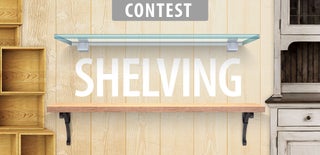Introduction: Sideboard to Work-space Upgrade
The Back Story
A few years ago I received a couple of wooden items from friends and family.
The first was a swing set, from my aunt, which promptly fell apart within six months of my setting it up in our yard. Wasn't really surprised by it: the one board that the swings hung from was so warped it could have appeared on Star Trek. Anyway, no-one got hurt in the fall so I took it down again, keeping the wood in case something came up that I could use it for.
The second item, received around the same time, was a small sideboard (an Ikea or Jysk type assembly). Some friends were getting rid of it because one of the doors had fallen apart and some other bit was cracked or something. I glued the broken bits together, fixed and re-hung the door, and chose a spot for it in the garage to hold some tools.
This summer, we moved. No longer do I have a garage. Instead, there is a smaller shed, meaning a smaller space for storage and projects. I had to leave behind one of my work tables. The small sideboard and the swing-set wood were among the things that made the move.
As I pondered on how I could more efficiently use the space, I had an idea for that sideboard. Using the old swing-set wood and some other bits I had, I came up with an upgrade that gave me:
- a table-top at a comfortable working height
- a space for a peg board to hold small tools
- a high shelf for items I don't use so much
- a hole-y shelf to hold chisels and screwdrivers
- and there's still space for another shelf if I decide to add it!
The camera was still packed away when I built it, not that I'm all that good at documenting my building process anyway. The assembly is straight-forward enough that some as-built images should suffice to spark ideas for someone who would like to do something similar.
Step 1: Affixing a New Frame
This is where some of the old swing set comes in. I have no clue what kind of wood it is, but it's dense, tough to drill into. There were two long 1"x4" braces, cross-cut to an acute angle on one end and square at the other. I cut a little off the square end so that they fit upright in my shed. You'll see these as the back legs and rising above the sideboard to support the pegboard, shelf, and other additions.
I found some other bits to be the front legs.
After cutting notches in the overhanging top and bottom pieces of the sideboard, the front and back legs were fastened to its sides. Some more strips were added to the bottom to add extra support for holding up the sideboard and to add rigidity to the structure. Now, going inside the sideboard, the screws I used went through both thicknesses of wood, posing a scratch hazard or impeding drawers, so I used a pair of pliers to bend the sticking out tips back and forth until they broke just above the wood surface. Then I filed the remainder flush with the wood.
A note that all fasteners used in this project were removed from other salvaged lumber. Thus no materials were purchased in the production of this piece. I love when I can say that!
Step 2: Adding Utility
With the legs attached, I took a step back to decide what tools would live here and how they'd be stored. I knew for sure that I wanted chisels and screwdrivers readily available, so a couple of 2"-wide lengths with 3/4" holes drilled along them were placed at slight forward angle just above the tabletop. Above those went the pegboard, which for now is a piece of plywood that just happened to be the right size, I think I want real pegboard there at some point.
To highlight one of the beautiful aspects of repurposing, a nicely decorated bit of plywood for a shelf at the top (I think it used to be part of a flower box).
Then came some handy afterthoughts:
- some holes drilled at an angle in the back legs for holding driver bits
- a strip on the side attached to the front and back legs to create a holder for things
- a couple of screws put in higher up on the sides to hold saws or whatever else.
There you have it, a simple creation to re-use and make more useful an already useful item. In the drawers are my sandpaper sheets and various odds'n'ends. In the cabinets are cans of nails and screws (salvaged and brand new), and some tools in small cases. Things will likely change as the stuff in the shed is rearranged (there are still things in there that will migrate into the house or into the hands of new owners as we continue to settle after the move), so this installation may stay a while or it might go after a year or two to make room for a different system. Until that day, I suspect it will serve me very well.

Participated in the
Shelving Contest 2016













